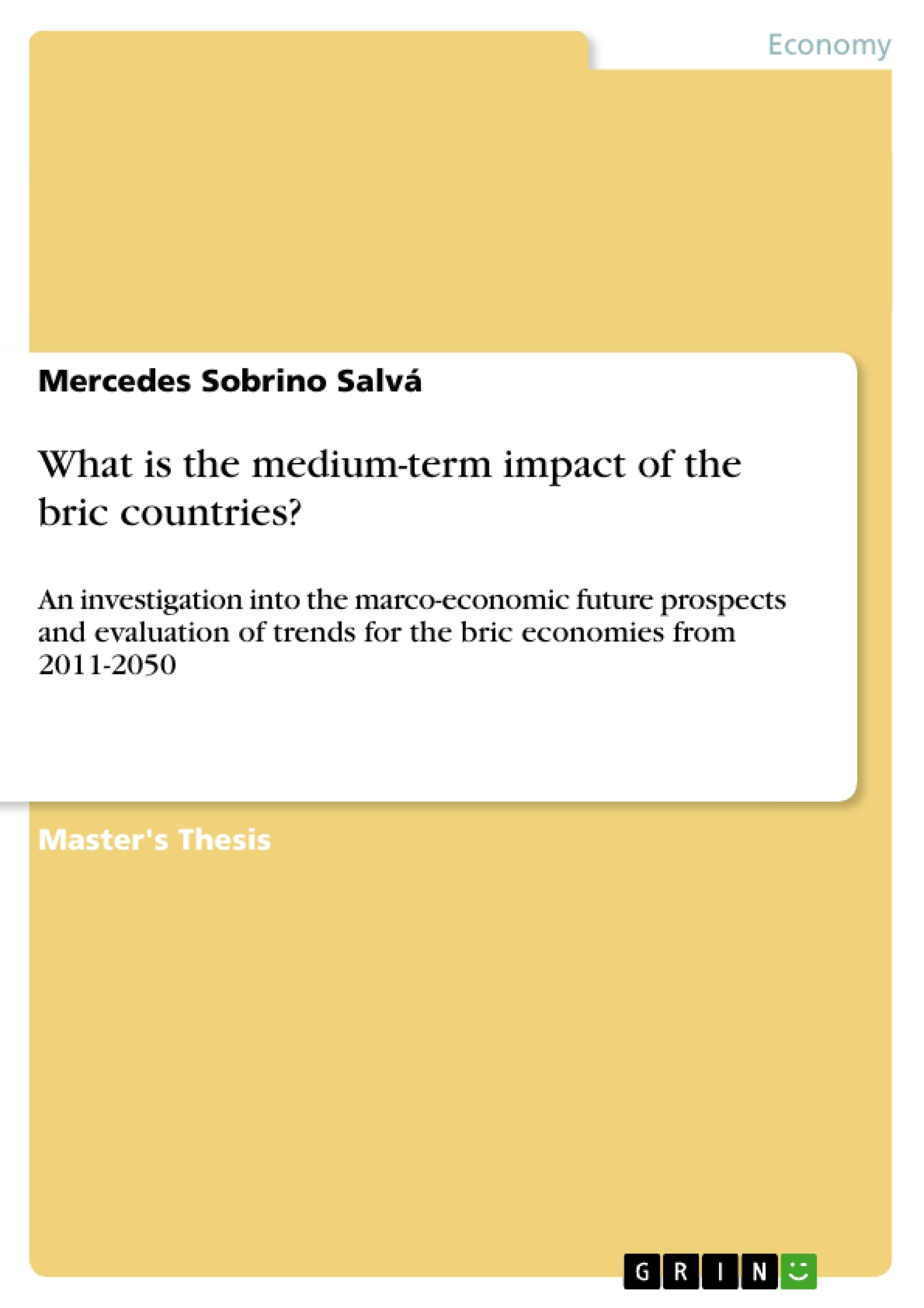The reason for this theme is based on a series of studies that began in 2001 with the Goldman Sachs (GS) Global Economic Teams and their document Dreaming with BRICs: The Path to 2050, which developed the BRIC hypothesis that groups together Brazil, Russia, India and China. Its relevance is based on the fact that the rise of the BRIC economies has been one of the major economic changes over the past few decades, and the fact that the BRICs are predicted by many to become the leading economies by 2050. However, these countries are predicted to be poorer on average than the G6 in per capita terms.
The first step of the current dissertation was to conduct a macro-environmental analysis with the purpose of investigating the future prospects of the BRICs, and, therefore, the socio-economic challenges that are believed to be actual and future constraints for the BRICs’ sustainable growth. As a result, it can be concluded that Brazil’s growth may not be sustainable unless there is a long-term financial shift; Russia’s growth sustainability requires an increase in population; India’s growth seems sustainable, yet the uneducated population might have negative effects at some point by 2050; and China’s growth is not likely to decline by 2020, but the socioeconomic challenges it faces might start to have an effect by 2030, meaning its growth rate might not be as robust as is now by 2050.
This study is also based on an economic model developed by the researcher, with the objective of investigating the BRICs’ prospects in GDP per capita terms, whose initial findings were analysed considering GS’s and PricewaterhouseCoopers’ (PwC) studies. As a result of this study, the BRICs are projected not to be the leader economies in per capita terms by 2050. However, considering that the long term and uncertainty are highly correlated, overall there is a high likelihood that neither GS’s predictions nor PwC’s nor the researcher’s can happen in the future.
Inhaltsverzeichnis (Table of Contents)
- CHAPTER 1
- INTRODUCTION
- CHAPTER OVERVIEW
- THE BACKGROUND TO THE STUDY: THE BRIC ECONOMIES
- RESEARCH AIM AND OBJECTIVES
- KEY TERMS
- OUTLINE OF THE DISSERTATION
- CHAPTER 2
- LITERATURE REVIEW
- CHAPTER OVERVIEW
- MACRO ENVIRONMENTAL ANALYSIS
- PESTLE framework's definition
- Brief history of PESTLE
- Advantages and disadvantages of PESTLE
- Discussion
- HOFSTEDE'S STUDY OF CULTURAL DIMENSIONS
- Arguments for and against Hofstede's study
- Discussion
- ECONOMIC GROWTH AND FACTORS UNDERPINNING ECONOMIC GROWTH
- Actual and potential economic growth
- Factors underpinning economic growth
- BUSINESS CYCLES THEORY
- Economic growth and business cycles
- Discussion
- RELATIONSHIP BETWEEN COMPETITIVENESS AND GROWTH
- Determinants of competitiveness
- The diamond of competitive advantage
- The World Economic Forum's The Global Competitiveness Report 2010-2011
- GLOBAL RISKS 2011, SIXTH EDITION
- SUMMARY
- CHAPTER 3
- METHODOLOGY
- CHAPTER OVERVIEW
- RESEARCH PHILOSOPHIES
- RESEARCH APPROACHES
- RESEARCH STRATEGIES
- Different tactics for pursuing research
- Methods of investigation
- RESEARCH CHOICES
- TIME HORIZONS
Zielsetzung und Themenschwerpunkte (Objectives and Key Themes)
This dissertation investigates the medium-term impact of the BRIC countries on the global economy, specifically examining their macro-economic future prospects and evaluating trends from 2011 to 2050.- The rise of the BRIC economies as a major economic shift in recent decades.
- The potential for the BRICs to become leading economies by 2050.
- The socio-economic challenges faced by the BRICs, including factors impacting their sustainable growth.
- An economic model developed by the researcher to investigate the BRICs' prospects in GDP per capita terms.
- The prediction of whether the BRICs will become leader economies in per capita terms by 2050, considering the high correlation between long-term projections and uncertainty.
Zusammenfassung der Kapitel (Chapter Summaries)
- Chapter 1 provides an introduction to the study, including its background, research aim and objectives, key terms, and outline.
- Chapter 2 presents a literature review, examining macro environmental analysis, Hofstede's study of cultural dimensions, economic growth, business cycles, competitiveness, and global risks.
- Chapter 3 outlines the methodology employed in the dissertation, including research philosophies, approaches, strategies, choices, and time horizons.
Schlüsselwörter (Keywords)
This dissertation focuses on the BRIC economies, macro-economic prospects, sustainable growth, socio-economic challenges, GDP per capita, economic models, and long-term predictions. The study utilizes frameworks such as PESTLE and Hofstede's cultural dimensions to analyze the BRICs' economic and social landscapes.- Arbeit zitieren
- Mercedes Sobrino Salvá (Autor:in), 2011, What is the medium-term impact of the bric countries?, München, GRIN Verlag, https://www.grin.com/document/170736




